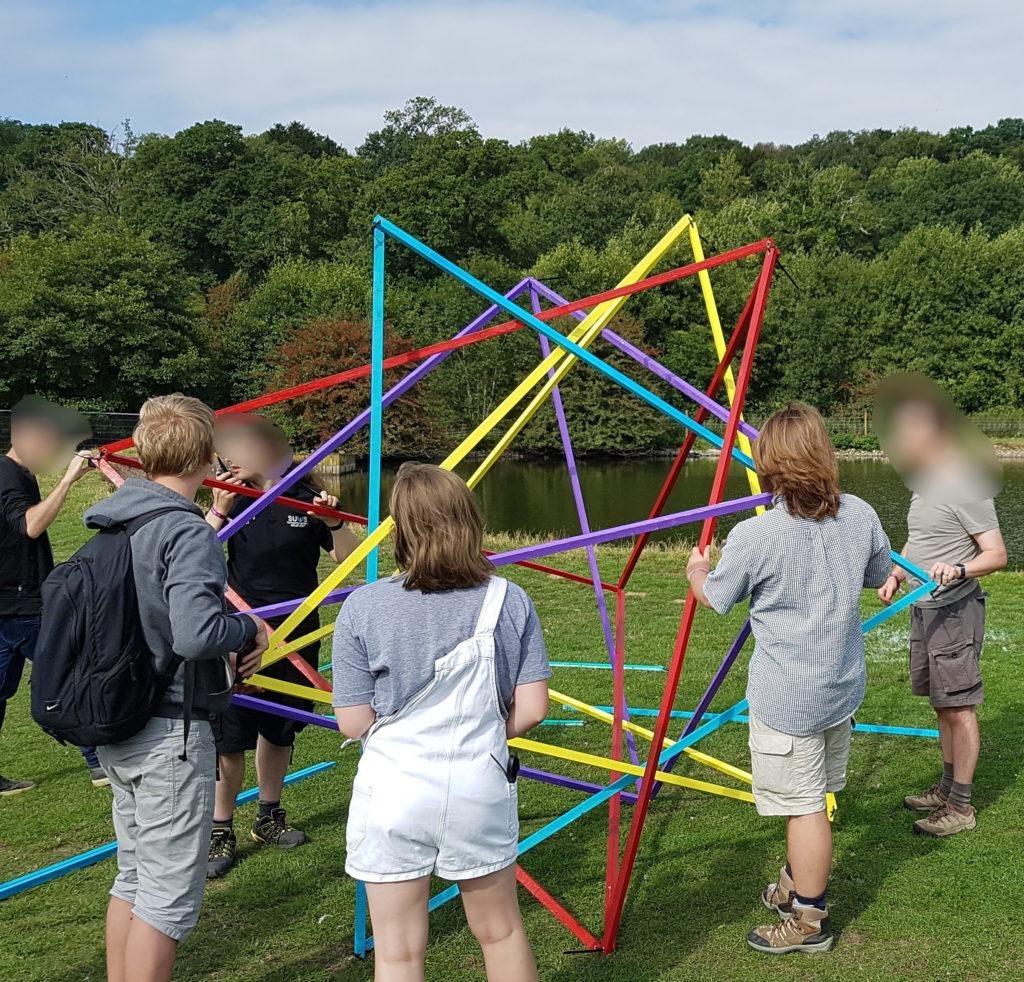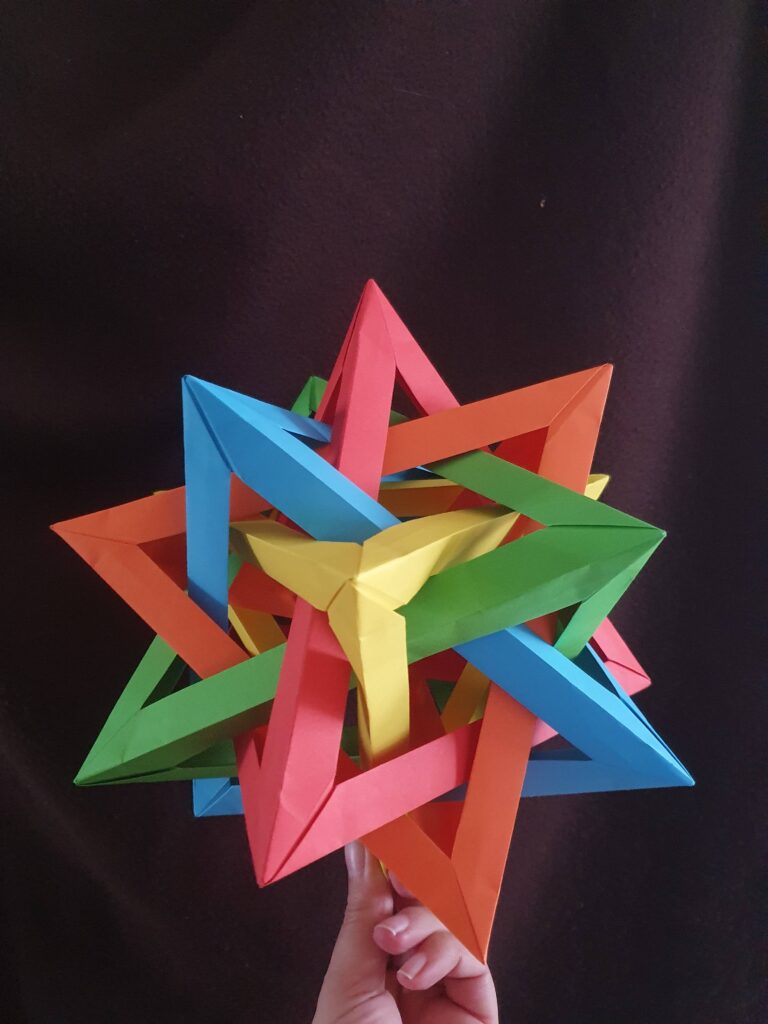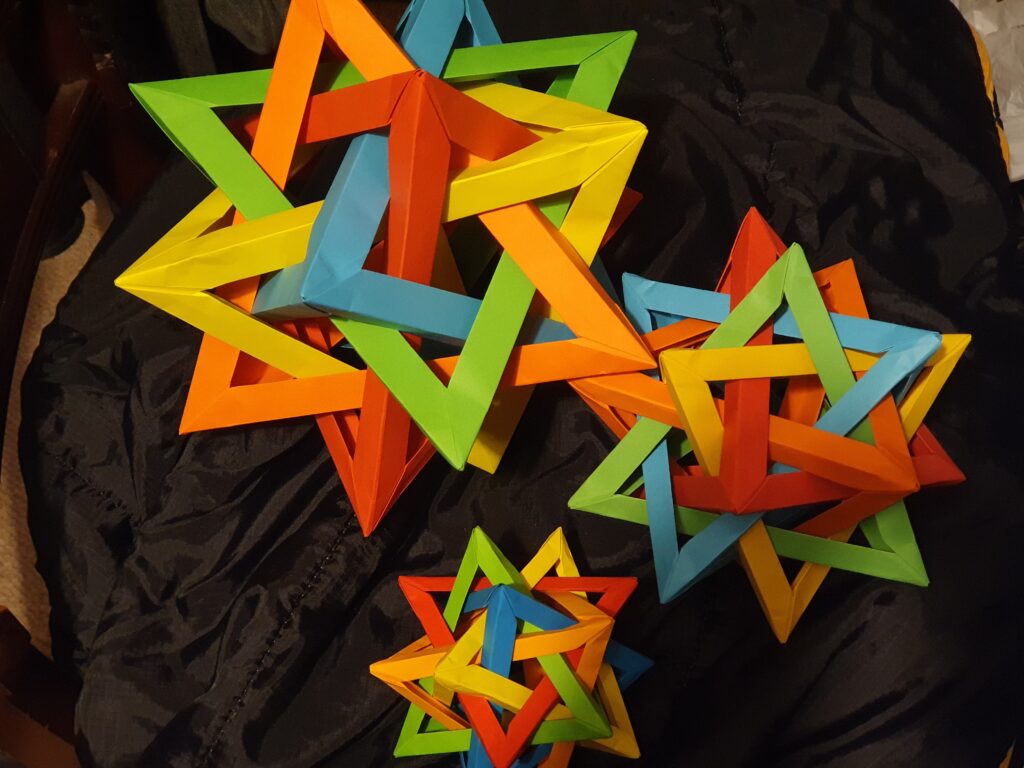Five intersecting tetrahedra
2020 has raised many challenges, and has required incredible patience from all of us. Patience as we wait for life to get back to normal, patience as rules change suddenly and plans are cancelled at the last minute, patience with technology as we cope with frozen screens, muted microphones, and unreliable broadband. There has also been solitude – my last day in an office with colleagues was March 16th, and by the time restrictions lifted to allow co-working again, I had moved on from my job and become a full-time freelancer, so I now spend much of my time enjoying my own company. It turns out that time and patience are the two ingredients needed to make an origami model I’ve had my heart set on making for many years…
I first came across the Five intersecting tetrahedra model in “The Origami Handbook” by Rick Beech, which I bought when I was a student in around 2002 or 2003. The model was designed by Tom Hull, and you can read more about it on his website. When I first saw the model I wanted to make it but having made one tetrahedron I abandoned the attempt because my paper was too flimsy and I did not think all five would stay together. I didn’t return to the model for more than a decade.
The tetrahedra crossed my path again at Electromagnetic Field in 2018. Matt Parker had a harebrained scheme to create a lit-up version of five intersecting tetrahedra made out of wood, and a bunch of us helped hold bits of the framework to try to get the lines going over and under each other in the right order. This was where I first appreciated that in the model, you can pair off tetrahedra using different colours to help you; if you have a red tetrahedron and a blue one, then the point of the red goes through the base of the blue and the point of the blue goes through the base of the red. In the completed model, every face of each tetrahedron has one of the other four colours going through it. This helps with the construction, though it wasn’t enough for me to get my head round the 3D geometry.

My next encounter with FIT, as it’s known to its friends, was at Talking Maths in Public 2019. I was part of a collaborative effort to make the model, under the guidance of Philipp Legner, founder of the excellent Mathigon website. There are instructions on Mathigon for making the FIT modules, and I’ve referred to these in making my own models.
I was delighted to be part of a group that successfully made the model but I was still determined to make my own some day. I thought that day might come in time for MathsJam 2019, when I gave a talk about dodecahedra. One way of understanding the five intersecting tetrahedra is by looking at the twenty vertices of a dodecahedron and partitioning them into five groups of four. I successfully created a 3D GeoGebra construction to help me better understand the geometry but I still couldn’t manage to put the origami model together – every time I tried I would get two tetrahedra together and part of the third and then become frustrated with which parts went over and which parts went under, and end up with battered and creased modules that were only fit for the recycling bin. MathsJam 2019 had to make do with a photo of the Talking Maths in Public model.
Fast forward to November 2020. I had spent a big chunk of the autumn doing origami; Fran Watson and I had put together webinars for Maths Weeks in Scotland and in England. I had also found that it was an ideal lockdown hobby – modular origami with its soothing repetitions kept me calm in a chaotic and frankly scary world. I had recently made a beautiful though complicated star from instructions on Paolo Bascetta’s website, and this somehow gave me the confidence to go back to the model that had become my nemesis. If I didn’t have the patience and dexterity to do it now, then perhaps I should make my peace that I never would…
I cut the pieces from some A4 paper – the model is folded from 3 by 1 rectangles. Each tetrahedron is made from 6 edges, so 30 rectangles cut from 10 squares of paper are needed in all. I folded the modules gradually in spare moments until all 30 were ready to assemble. Then I put together the first two tetrahedra and got stuck again. It was the evening before Big MathsJam, and I thought to myself how lovely it would be if I could start my 2020 talk tying up the loose end from 2019. That gave me the motivation I needed. I read Michal Kosmulski’s assembly tips, and then sat at my desk manipulating paper and comparing it with the diagrams. I got a third tetrahedron in, then a fourth, and finally, all five were together! I then proceeded to tell everyone I could think of, including Twitter!
So, what advice would I offer someone else who wanted to make this model?
Well, first of all, it’s much easier to make it once you’ve already made it! Having an actual 3D real life model to compare it to made the assembly of my second, third and fourth attempts much smoother than the first one. (Yes, I’ve got an origami problem. Yes, I’ve stopped making them now. Yes, I would make another one given half a chance.) For your first model though, it really does help to look at someone else’s diagram, so here’s a photo of one of mine with some notes that might be useful.

Note also how the remaining three colours weave themselves around the three yellow edges, in a sort of knot.
Put these edges in place, and then make the visible points, and then finally turn the model round to complete the faces – I found it easier to make sense of the symmetry by building the third, fourth and fifth tetrahedra together rather than one by one.
If you’re a fan of modular origami and you have the patience to tackle a complicated model, (or the three-dimensional thinking to make it easier to visualise the assembly), I think it’s definitely worth making at least once. I made a version from shiny paper which I suspect will adorn my Christmas tree for quite a few years to come. Origami is a great tool for helping young people understand the importance of care, precision and perseverance, and while I wouldn’t necessarily teach this model in an origami workshop, I will certainly use it as an example to inspire!

